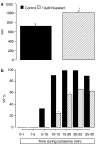Nupafant, a PAF-antagonist prototype for suppression of ventricular fibrillation without liability for QT prolongation?
- PMID: 16921398
- PMCID: PMC2014274
- DOI: 10.1038/sj.bjp.0706846
Nupafant, a PAF-antagonist prototype for suppression of ventricular fibrillation without liability for QT prolongation?
Erratum in
- Br J Pharmacol. 2006 Dec;149(7):966
Abstract
Background and purpose: PAF antagonists inhibit ischaemia-induced ventricular fibrillation (VF) in animals. However, unfavourable ancillary actions (on QT interval and coronary flow) have been reported with the PAF antagonist, BN-50739. If these are class actions, they would preclude development of PAF antagonists as novel anti-VF drugs. Our purpose was to examine this proposition using the hitherto untested PAF antagonist, nupafant.
Experimental approach: Two rat heart preparations (Langendorff and 'dual coronary' perfusion) were used to assay nupafant's effects on ischaemia-induced VF, coronary flow and QT interval, and to test for the site-selectivity necessary if any effects on VF are caused by PAF antagonism.
Key results: Global (whole-heart) delivery of 10 microM nupafant, reduced the incidence of ischaemia-induced VF and widened QT interval without affecting coronary flow. Importantly, lower concentrations (0.1 and 1 microM) had no effect on VF, yet widened QT almost identically to 10 microM nupafant. When nupafant was delivered selectively to (and entrapped within) the involved region it partially protected against VF (P<0.05). This occurred without change in QT interval. Selective nupafant delivery to the uninvolved region was without effect.
Conclusions and implications: Nupafant protects against ischaemia-induced VF primarily by site-selective actions in the ischaemic region but, unlike BN-50739, the effect is unrelated to its QT widening action, and is not compromised by any effect on coronary flow. This establishes proof of concept that VF suppression by PAF antagonism need not invariably be associated with QT prolongation or vasodilatation, justifying further development of this drug class.
Figures




References
-
- Annable CR, Mcmanus LR, Carey KR, Pinckard RN. Isolation of platelet activating factor from ischaemic baboon myocardium. Fed Proc. 1985;44:1271.
-
- Arakawa H, Qian J-Y, Baatar D, Karasawa K, Asada Y, Sasaguri Y, et al. Local expression of platelet-activating factor-acetylhydrolase reduces accumulation of oxidized lipoproteins and inhibits inflammation, shear stress-induced thrombosis, and neointima formation in balloon-injured carotid arteries in nonhyperlipedemic rabbits. Circulation. 2005;111:3302–3309. - PubMed
-
- Avkiran M, Curtis MJ. Independent dual perfusion of left and right coronary arteries in isolated rat hearts. Am J Physiol. 1991;261:H2082–H2090. - PubMed
-
- Baker KE, Curtis MJ. Protection against ventricular fibrillation by the PAF antagonist, BN-50739, involves an ischaemia-selective mechanism. J Cardiovasc Pharmacol. 1999;34:394–401. - PubMed
-
- Baker KE, Curtis MJ. Left regional cardiac perfusion in vitro with platelet-activating factor, norepinephrine and K+ reveals that ischaemic arrhythmias are caused by independent effects of endogenous ‘mediators' facilitated by interactions, and moderated by paradoxical antagonism. Br J Pharmacol. 2004;142:352–366. - PMC - PubMed
Publication types
MeSH terms
Substances
LinkOut - more resources
Full Text Sources

